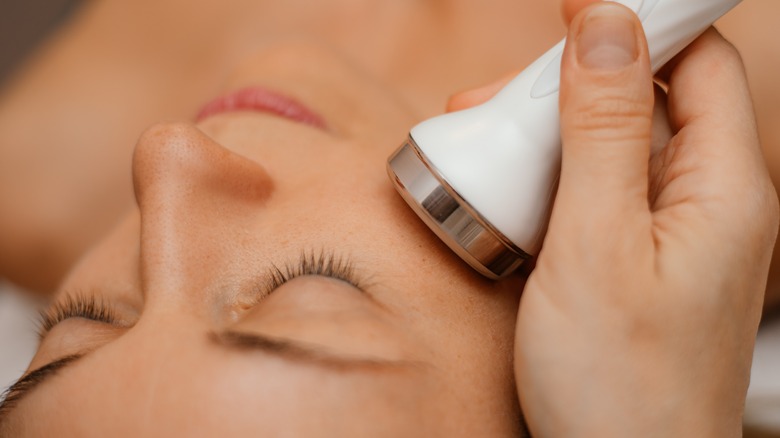What's The Difference Between Dermabrasion And Microdermabrasion?
If you have fine lines, dark spots, acne scars, or other facial characteristics you're not fond of, you've likely tried everything from facial cleansers to creams to retinol. You've also probably heard about procedures like dermabrasion and microdermabrasion, but what are they and what is the difference between them?
The purpose of both microdermabrasion and dermabrasion is to even out the surface of the face by smoothing scars, bumps, and other abnormalities that contribute to an uneven texture, according to the American Society of Plastic Surgeons. While both procedures share a common goal, the ways in which they are performed and the intensity with which the skin is planed vary significantly. Of the 2 procedures, dermabrasion is the more intense and invasive option.
Anyone can seek out dermabrasion and microdermabrasion, regardless of gender or age (per MedicineNet). However, the procedures are most often performed on people ages 12-65. After age 70, the risk of bruising and damage to the skin drastically increases, although there is no official age limit for the procedures. Microdermabrasion is typically safe for all skin types, whereas dermabrasion is usually restricted to fair skin since darker skin is more susceptible to negative side effects, such as discoloration and scarring (via WebMD). To determine if you are a candidate for either of these cosmetic practices, it is best to talk with your doctor, who can assess your specific skincare needs.
Here is what you should know about dermabrasion and microdermabrasion.
Dermabrasion is more intense
Dermabrasion is a procedure that improves the contour of the skin. It smooths the treated area by sanding the skin and allowing a new smoother layer to grow (via the Cleveland Clinic). The word "dermabrasion" itself describes the procedure with the meaning "scraping of skin." Broken down, the word "derm" means "skin," and "abrasion" means "scraping something away."
According to the Mayo Clinic, dermabrasion is performed with a device that quickly rotates to resurface the treated area by taking off the outer layer. This process is sometimes referred to as "sanding" or "planing" of the skin. The intent is for the skin that is removed to grow back smoother than it was before, thus softening the appearance of acne scars, fine lines, wrinkles, age spots, and scars. Because the outer layer of facial skin is taken off during the procedure, the face is usually red and may even bleed immediately afterward. Patients should expect the skin to have a blotchy semblance and sensitivity for up to 3 months until the treated area is restored to its normal skin tone.
When dermabrasion is performed, the skin is usually numbed with a local anesthetic, but sometimes, there may be an option to take a sedative (per the Mayo Clinic). In extreme cases where significant scraping of the skin is required, patients may be admitted to the hospital and put under general anesthesia. Whether performed in-office or in a hospital setting, only a trained medical professional should perform dermabrasion.
Microdermabrasion is gentler on your skin
If you're looking for a less intense procedure, microdermabrasion may be right for you. Microdermabrasion is considered to be much gentler than dermabrasion, according to WebMD. It is often described as an experience of skin rejuvenation and exfoliation that can lead to brighter, softer skin. Microdermabrasion is performed by spraying tiny crystals onto the skin, which tenderly remove the outer layer of the skin by eliminating dead and dull skin cells. Sometimes, the procedure is performed using a tool with miniature crystals on it. They are slowly worked into the skin in a fashion similar to exfoliation (via the Dermatology Center of Northwest Houston).
While dermabrasion requires weeks of healing, microdermabrasion only entails approximately 24 hours to recover (via WebMD). Unlike the more intense dermabrasion procedure that can lead to bleeding and significant redness, the side effects of microdermabrasion typically only include slight pinkness for a few hours following the procedure. This is because microdermabrasion removes dead skin cells on the surface of the skin, whereas dermabrasion goes deeper and can actually remove active skin cells below the surface (per Westlake Dermatology).
Another difference between the 2 procedures is in the availability of options. Whereas dermabrasion should only be performed by trained professionals, there are many at-home microdermabrasion kits available, reports Cosmopolitan. As always, consult with your healthcare provider before starting new skin routines, including at-home solutions. They can go over what is best for your unique skin.



